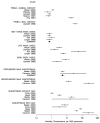Rethinking the heterosexual infectivity of HIV-1: a systematic review and meta-analysis
- PMID: 18684670
- PMCID: PMC2744983
- DOI: 10.1016/S1473-3099(08)70156-7
Rethinking the heterosexual infectivity of HIV-1: a systematic review and meta-analysis
Abstract
Studies of cumulative HIV incidence suggest that cofactors such as genital ulcer disease, HIV disease stage, and male circumcision influence HIV transmission; however, the heterosexual infectivity of HIV-1 is commonly cited as a fixed value (approximately 0.001, or one transmission per 1000 contacts). We sought to estimate transmission cofactor effects on the heterosexual infectivity of HIV-1 and to quantify the extent to which study methods have affected infectivity estimates. We undertook a systematic search (up to April 27, 2008) of PubMed, Web of Science, and relevant bibliographies to identify articles estimating the heterosexual infectivity of HIV-1. We used meta-regression and stratified random-effects meta-analysis to assess differences in infectivity associated with cofactors and study methods. Infectivity estimates were very heterogeneous, ranging from zero transmissions after more than 100 penile-vaginal contacts in some serodiscordant couples to one transmission for every 3.1 episodes of heterosexual anal intercourse. Estimates were only weakly associated with study methods. Infectivity differences, expressed as number of transmissions per 1000 contacts, were 8.1 (95 % CI 0.4-15.8) when comparing uncircumcised to circumcised susceptible men, 6.0 (3.3-8.8) comparing susceptible individuals with and without genital ulcer disease, 1.9 (0.9-2.8) comparing late-stage to mid-stage index cases, and 2.5 (0.2-4.9) comparing early-stage to mid-stage index cases. A single value for the heterosexual infectivity of HIV-1 fails to reflect the variation associated with important cofactors. The commonly cited value of 0.001 was estimated among stable couples with low prevalences of high-risk cofactors, and represents a lower bound. Cofactor effects are important to include in epidemic models, policy considerations, and prevention messages.
Conflict of interest statement
Figures


References
-
- UNAIDS, WHO. AIDS Epidemic Update: December 2007. Geneva: UNAIDS; 2007.
-
- Smith RJ, Bodine EN, Wilson DP, Blower SM. Evaluating the potential impact of vaginal microbicides to reduce the risk of acquiring HIV in female sex workers. Aids. 2005 Mar 4;19(4):413–21. - PubMed
-
- Pinkerton SD, Layde PM, DiFfranceisco W, Chesson HW. All STDs are not created equal: an analysis of the differential effects of sexual behaviour changes on different STDs. International Journal of Std & Aids. 2003 May;14(5):320–8. - PubMed
-
- Smith DK, Grohskopf LA, Black RJ, Auerbach JD, Veronese F, Struble KA, et al. Antiretroviral postexposure prophylaxis after sexual, injection-drug use, or other nonoccupational exposure to HIV in the United States: recommendations from the U.S. Department of Health and Human Services. MMWR Recomm Rep. 2005 Jan 21;54(RR2):1–20. - PubMed
-
- Gisselquist D, Potterat JJ, Brody S. Running on empty: sexual co-factors are insufficient to fuel Africa's turbocharged HIV epidemic. Int J STD AIDS. 2004 Jul;15(7):442–52. - PubMed
Publication types
MeSH terms
Grants and funding
LinkOut - more resources
Full Text Sources
Medical
Miscellaneous

